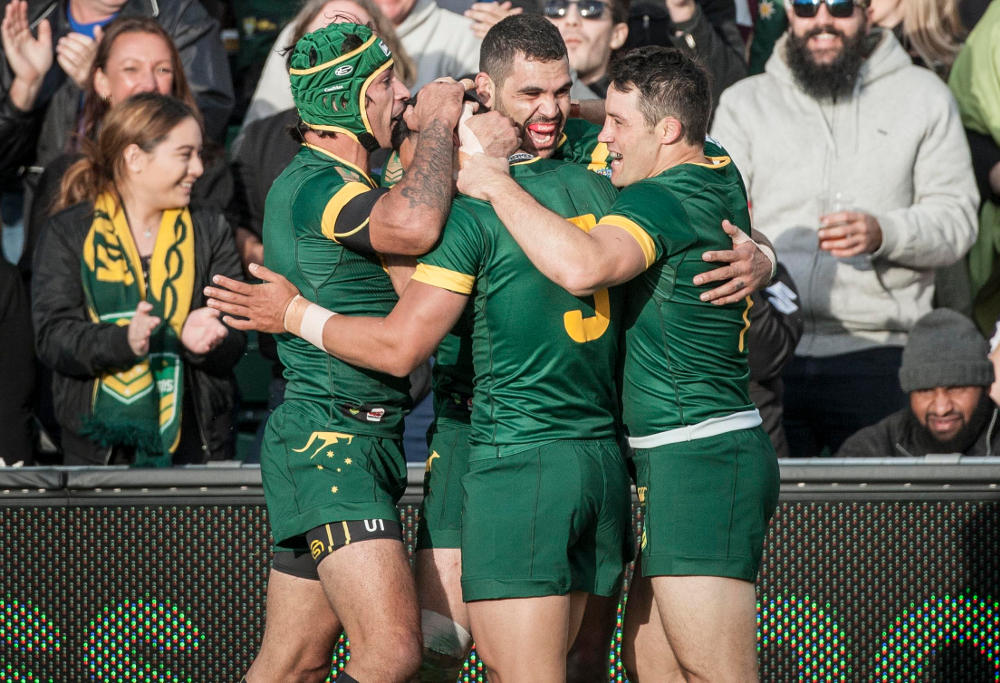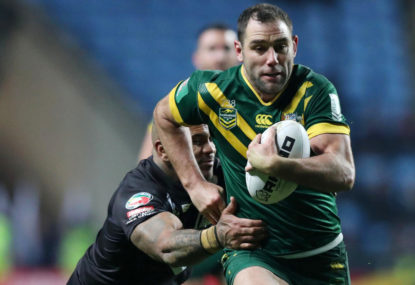Right back at the dawn of rugby league, there was a time when Australia was not the dominant force in the international game.
They played 11 Tests between 1908 and 1910 for seven losses, a draw and just three wins.
In the decades after World War I there were distinct periods of mediocrity where both England and New Zealand clearly had the wood on Australia:
Between July 10, 1920, and November 13, 1937, Australia played 30 Tests and lost 20 of them (66%).
From June 17, 1946, to July 23, 1955, Australia played 39 Tests and lost 22 of them (56%).
In fact, the Australian side lost 53 of their first 95 Tests – 56 per cent. There were also four draws, meaning that they won just 40 per cent of their matches.
Fast forward to now and you’ll find that the Kangaroos have a 68 per cent all-time winning record against all nations. Of the 278 Tests they’ve played since July 1955, they’ve won 214, or 77 per cent, of them.
However, it is in the last four decades that their dominance has been almost absolute. From June 16, 1979, to today they have played 164 Tests for 22 losses, three draws and 139 wins. That’s a winning ratio of 85 per cent. To put that dominance in perspective, the All Blacks have only had an 83 per cent win ratio during the same period.

Only once in that entire run have the Kangaroos lost consecutive matches: the 2014 Four Nations final and the 2015 Anzac Test, both against the Kiwis.
It is worth noting, though, that in that same period the Kiwis have played 180 Tests for 87 wins (48 per cent win ratio). However, 75 of those 180 games (47%) were against Australia and the lads from the land of the long white cloud only won 15 of them. That’s just 20 per cent.
45 of their victories were against teams of the likes of France, Papua New Guinea, Tonga, Samoa and the Cook Islands. While I’m sure our jandal-wearing cousins were heartily congratulating each other as they cracked open the chilly bin and said “sweet as” and “chur bro” after beating each minnow league nation, beating the Cook Islanders ain’t exactly a Herculean feat bro…
Then there’s the Poms. Now, they break into two categories. Once upon a time, we knew them as Great Britain, an amalgamation of the best English, Welsh and Scottish players, with the odd Northern Irishman thrown in.
For all their amalgamated selections, between 1979 and 2006, Australia were hardly ruled by Britannia; the Kangaroos won 33 of the 40 encounters.
However, the last time we saw them was a decade ago. Since then, the Kangaroos have played the less fearsome England. Between 1995 and the present the English have taken on the Kangaroos 11 times. The only time the boys in white have triumphed was way back in 1995.
As with the Kiwis, the Poms have fared better against the sides that aren’t the Kangaroos. They have won 22 (56%) of their remaining 39 Test matches from 1995 against non-Australian sides. However, they’ve only managed four wins from their 11 Tests against New Zealand.
That means 18 of their 22 wins (82%) have come against minnow league nations.
In spite of these damning statistics, the reality is that England and New Zealand are the only real competition for the mighty Kangaroos. So why has the Australian rugby league team been so dominant over the last 40 years?
Three words: State of Origin.

It is no coincidence that the start of the interstate series in 1980 coincides with the beginning of the era of Kangaroo dominance.
Origin is unique in world rugby league. No other nation has a top-tier domestic competition that pits their very best players against each other in games that involve such fierce passion and competition. State of Origin has (very) arguably become the pinnacle of rugby league. The players blooded in that cauldron can step easily into the international arena.
In fact, you could argue that is a step down.
Further, not only do the State of Origin contests create better players, they also entice players to Australia from other nations with the lure of $30,000 a game and playing in the game’s showpiece event.
Some argue that a number of New Zealand and Fijian-born players have declared themselves New South Welshmen or Queenslanders just to get themselves involved. James Tamou, Josh Papalii, Ben Te’o, Karmichael Hunt, Lote Tuquiri, Tonie Carroll and Brad Thorn all declared their allegiance to Australia rather than the country of their birth, strengthening the Kangaroos at their opponents’ expense.
Big Jim Tamou, a New Zealand Maori in 2008, is no longer available to bolster the Kiwis’ front row as he is now a true blue, ridgey didge Aussie. Just like Aussie Semi is.
So on one hand you have the Kangaroos massively advantaged by State of Origin – giving those players a battle hardiness not available to other nations – and on the other hand you have other nations losing some excellent players.
The flash in the pan Super League experiment came up with a lot of ideas that were deservedly short-lived. However, one that I liked was the tri-series between NSW, Queensland and New Zealand. While it did subjugate our sister nation to the status of a state – something the Australian Constitution (covering clause 6) says can happen anytime they give up on their experiment – it also gave their top tier players more experience and opportunity.
While the comparative combined first grade and international experience of the Australian, English and New Zealand squads are quite similar, the State of Origin experience of the Australians also gives them an edge in games played experience. Just have a look at these numbers for each side’s current best 17:
New Zealand
Average of 155 first grade games (2638 total combined) and an average of 18 international caps each (304 total combined), for an average of 173 top level games each.
England
Average of 182 first grade games (3106 total combined) and an average of 11 Test caps (190 total combined), for an average of 193 top level games each.
Australia
Average of 182 first grade games (3092 total combined), and an average of 15 Test caps (259 total combined), and 15.5 State of Origin games (266 total combined), for an average of 212.5 top level games each.
While New Zealand currently sit atop the Rugby League International Federation rankings, there is little doubt Australia is clearly the preeminent rugby league nation.
The only slight argument against it is that New Zealand have won three of the last six Three or Four Nations titles, and one of the last two Rugby League World Cups. In each case, they beat Australia in the final.
So what went wrong for the Kangaroos on each of those occasions?
The 26-0 victory for the Kiwis in the final of the 2005 Tri-Series was described as a pulverisation and dismantling of Australia. Further, it was declared to be the end of Australia’s dominance of world rugby league.
The truth was the Kangaroos’ star halves combination of Andrew Johns and Darren Lockyer both did not play in the match. In their absence, the halves pairing of Trent Barrett and Craig Gower was unable to emulate the magic of the Bronco and the Knight. The Kiwis took full advantage of that.
In the 2008 World Cup final, the Kangaroos just had a bad night. Their usually great ball control deserted them and they gifted the Kiwis lots of possession and points, highlighted by Billy Slater’s uncharacteristic howler when he threw a ball directly to Benji Marshall to score.
Playing catch-up footy from that point on, they were on the wrong end of a penalty try call by English video referee Steve Ganson, that many – including coach Ricky Stuart, whose subsequent abuse of the whistle blowers cost him his job – thought was just plain wrong. The Kiwis ran out 34-20 winners.
The 2010 Four Nations final was all about Benji Marshall. At the peak of his powers, the then Wests Tigers five-eighth put on two moments of brilliance to turn a 12-4 deficit with nine minutes to go into a last-gasp victory. The Kangaroos were better for the vast majority of the match but just didn’t finish the Kiwis off. Marshall made them pay dearly for it.
The 2014 Four Nations final saw the Kiwis’ ball handling near perfect in the first 40 minutes, accompanied by the enigmatic Shaun Johnson having an ‘on’ night. The Kangaroos, conversely, had no luck. Josh Mansour knocked on over the line and Corey Parker was held up. The second half saw a Kangaroos’ fight back that was cruelly halted by a forward pass ruling by referee Phil Bentham that had many scratching their heads and saw the Kiwis hold on to win 22-18.

Don’t expect one of these incidents to happen on November 20. For a starter, 2010 model Benji Marshall won’t be there to pull a rabbit out of the hat in the Kiwi number six jersey.
Instead, we’ll see a brand new Kiwi number Six after 31-year-old hooker-cum-five-eighth Thomas Leuluai broke his jaw. Further, Jordan Kahu will be in the fullback role rather than the brilliant Roger Tuivasa-Sheck.
On top of that, the Australian side has their deadly spine ready to go. The 9-7-6-1 combination of Cameron Smith, Cooper Cronk, Johnathan Thurston and Darius Boyd has been all-conquering for Queensland. The only series the Maroons have has lost was in 2014 when Cronk was injured and Daly Cherry-Evans filled in. There’ll be no such respite for the Kiwis.
What there will be is unrelentingly clinical and brutal football served up in spades.
As a result, the Kangaroos are almost dead certainties to retain the Rugby League World Cup at home in 2017 and to win the Four Nations on 20 November in London.
They are coming to take back what is theirs.
































































































